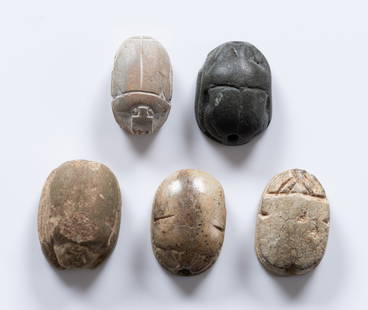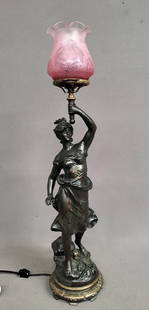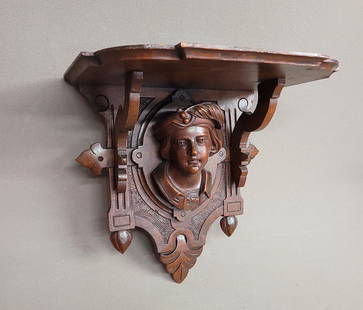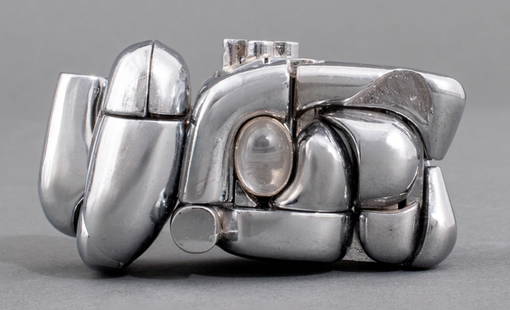
Egyptian Limestone Stele Fragment
Similar Sale History
View More Items in Sculptures & CarvingsRelated Sculptures & Carvings
More Items in Sculptures & Carvings
View MoreRecommended Art
View More



Item Details
Description
Egypt, New Kingdom, Dynasty XIX-XX, ca. 1292 - 1069 BCE. Showing a standing figure beneath outstretched wings of Isis, with a nice band of hieroglyphs directly above figure’s head. 5-1/4"H x 1-3/4"W. Custom stand. Provenance: Ex-Gustave Jéquier collectionGustave Jéquier - Gustave Jéquier was born in 1868 in Neuchâtel, Switzerland. Jéquier began his career as an Egyptologist under the direction of Gaston Maspero and Jacques de Morgan. His primary focus was on the Predynastic Period, which runs from the earliest human occupation of Egypt to the beginning of the Early Dynastic Period of Egypt, starting with King Menes. Egyptian and temple architecture captivated Jéquier, therefore he focused his attention on the Old and Middle Kingdom pyramids. He later published several books on temple architecture.Gustave Jéquier participated in major excavations sponsored by the Supreme Council of Antiquities including southern cemeteries of Saqqara, Aba, Dahshur, Lisht, and Mazghuna. In 1901, he joined Jacques de Morgan's Susa expedition, which led to the discovery of the famous Code of Hammurabi. Hammurabi was the sixth king of Babylonia and he created 282 laws to regulate people’s actions and relationships including work, marriage, crime, land ownership, and sex. One of his most recognizable scaled punishments was "an eye for an eye, a tooth for a tooth", which of course depended upon social status. In 1928, consequently, he discovered the Mastabat Faraoun of Shepseskaf.Gustave Jéquier worked on the Pyramid Texts, which are dated to the Old Kingdom and believed to be the oldest evidence of religious works in the world. His work with the Texts provided scholars with a better understanding of religion at that time. Gustave Jéquier was also the first Egyptologist to excavate the pyramid complex of Pepi II between 1926 and 1936. Pepi II was pharaoh of the Sixth dynasty in Egypt's Old Kingdom. Jéquier was also the first excavator who found remains from the tomb reliefs, and the first to publish a thorough excavation report on the complex.Additionally, Jéquier found several food cases within the enclosure wall of Queen Oudjebten’s pyramid complex at South Saqqara, which he dated to the last third reign of Pepi II. This means the food cases were dated to the last year they were used.Gustave Jéquier died in 1946, but not without leaving an incurable legacy of discoveries.
Condition
There is no buyer’s premium added to the sale.
The absence of a condition statement does not imply that the lot is in perfect condition or completely free from wear and tear, imperfections or the effects of aging. If you have any questions, please contact us. All transactions are governed by Antiques & Artifacts LLC's Conditions of Sale
Buyer's Premium
- 0%
Egyptian Limestone Stele Fragment
Estimate $2,500 - $3,500
3 bidders are watching this item.
Get approved to bid.
Shipping & Pickup Options
Item located in Cape Coral, FL, usSee Policy for Shipping
Payment

TOP


























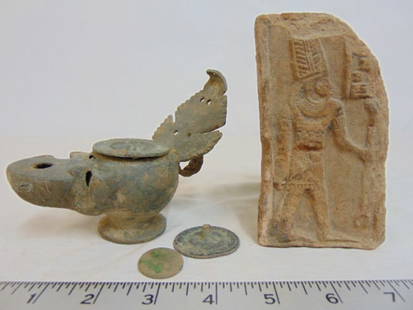
![Egypt-Style Stone Sculpture Fragment: Egyptian-style stone sculptural fragment, mounted on a square wood base. [Sculpture: 21 1/2 x 4 1/4 x 4 1/4 inches; Base: 2 1/2 x 5 x 5 inches]. In good condition.](https://p1.liveauctioneers.com/1221/140618/71592036_1_x.jpg?height=310&quality=70&version=1557083937)








![EGYPTIAN PROFILE BUST IN STONE, 4TH CENTURY: EGYPTIAN PROFILE BUST IN STONE, 4TH CENTURY dimensions: 13 x 9 x 4 cm (5 1/8 x 3 1/2 x 1 5/8 in.) [with the wooden base]](https://p1.liveauctioneers.com/394/324829/174825226_1_x.jpg?height=310&quality=70&version=1711998515)








